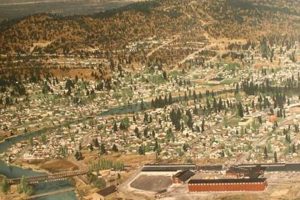Determining the optimal period to travel to Bend, Oregon, hinges on individual preferences regarding weather conditions, available activities, and desired crowd levels. This determination involves evaluating the characteristics of each season and how they align with specific travel goals. Consideration should be given to factors such as temperature ranges, precipitation likelihood, and the availability of seasonal recreational opportunities.
Selecting a suitable timeframe for a Bend visit significantly enhances the overall travel experience. A well-chosen period can provide access to ideal conditions for outdoor pursuits, such as hiking, skiing, or water sports. Moreover, strategic timing can minimize exposure to inclement weather and reduce the potential for overcrowded attractions. Historically, visitor influx has varied significantly throughout the year, influencing accommodation availability and pricing.
Therefore, a detailed exploration of Bend’s seasonal attributes is essential for effective trip planning. The subsequent sections will delve into the nuances of each season, providing insights into the unique advantages and disadvantages associated with visiting Bend during different times of the year. This analysis will empower readers to make informed decisions that optimize their travel experiences.
Optimizing a Trip to Bend
Strategic planning, centered around seasonal considerations, can significantly enhance a visit to Bend, Oregon. The following tips offer guidance for aligning travel dates with specific interests and preferences, ensuring a more fulfilling experience.
Tip 1: Consider Shoulder Seasons: Spring (April-May) and Fall (September-October) often provide a balance between pleasant weather and fewer crowds. These periods can be ideal for hiking and exploring the outdoors without the peak-season congestion.
Tip 2: Evaluate Weather Patterns: Bend experiences distinct seasons. Summer (June-August) offers warm, dry weather suitable for water activities. Winter (November-March) brings snow, attracting skiers and snowboarders. Research historical weather data to anticipate potential conditions.
Tip 3: Factor in Event Schedules: Bend hosts numerous events throughout the year, ranging from music festivals to outdoor recreation competitions. Aligning a trip with a specific event can enhance the experience, but it may also increase accommodation costs and crowd sizes.
Tip 4: Assess Activity Priorities: The best timeframe for a visit depends on the desired activities. Skiing and snowboarding are best enjoyed during winter. Hiking and mountain biking are typically optimal during summer and shoulder seasons. Water sports thrive in the summer months.
Tip 5: Book Accommodations in Advance: Especially during peak seasons and around popular events, securing accommodations well in advance is crucial. This ensures availability and often allows for access to better rates.
Tip 6: Pack Appropriately: Regardless of the season, preparing for variable weather conditions is advisable. Layered clothing is recommended, allowing for adjustments to changing temperatures. Sun protection is essential year-round.
Tip 7: Be Aware of Wildfire Season: Summer and early fall can be wildfire season in Central Oregon. Monitor air quality reports and fire restrictions before and during a visit, and be prepared to adjust plans if necessary.
Careful consideration of these elements can result in a visit that effectively aligns with individual preferences, optimizing the enjoyment of Bend’s diverse offerings. Selecting a timeframe informed by weather patterns, activity priorities, and event schedules is fundamental for a successful trip.
The following section provides a detailed look at specific activities available in Bend, and how they can influence your timeline to visit.
1. Weather Conditions
Weather conditions exert a substantial influence on the optimal visitation period to Bend, Oregon. Understanding the nuances of each season’s climate is crucial for aligning travel dates with desired activities and preferences. The following outlines key weather-related considerations.
- Temperature Variations
Bend experiences significant temperature fluctuations throughout the year. Summer months (June-August) typically feature warm days, often reaching the 70s and 80s Fahrenheit, with cooler nights. Winter (November-March) sees daytime temperatures often hovering around freezing, with nighttime lows frequently dipping below zero. Spring and fall offer transitional temperatures, varying widely but generally milder than summer or winter extremes. These variations directly impact the suitability of activities such as hiking, skiing, and water sports, influencing when certain experiences are most enjoyable.
- Precipitation Patterns
Precipitation patterns also vary seasonally. Winter is the wettest period, with snowfall common in the higher elevations and rain or snow in the city itself. Summer is typically dry, with minimal rainfall. Spring and fall experience moderate precipitation. Snowfall affects access to mountain areas and dictates the availability of winter sports, while the lack of summer rain creates ideal conditions for outdoor pursuits such as mountain biking and rock climbing.
- Sunshine Hours
Bend is known for its high desert climate, which results in abundant sunshine throughout the year. However, the number of daylight hours varies significantly. Summer offers long days with extended daylight, maximizing time for outdoor activities. Winter days are shorter, reducing the available time for daylight pursuits. Spring and fall offer intermediate daylight hours. The duration of daylight affects the feasibility of activities such as hiking and sightseeing, particularly for visitors who prefer to maximize their daylight hours.
- Wind Factors
Wind conditions can play a role in comfort levels and activity suitability, particularly in open areas and at higher elevations. Bend can experience strong winds, particularly during the spring and fall months. Understanding prevailing wind patterns is important for planning activities such as fishing, kayaking, or simply enjoying a day outdoors.
In summary, the relationship between weather conditions and the ideal visitation period is inextricably linked. Travelers should carefully consider their tolerance for varying temperatures, precipitation levels, and daylight hours when planning a trip to Bend, ensuring that their chosen timeframe aligns with their desired activities and comfort levels.
2. Recreational Activities
The availability and suitability of recreational activities in Bend, Oregon, are intrinsically linked to the time of year. The optimal period for a visit is often determined by the specific activities a traveler wishes to pursue.
- Skiing and Snowboarding
The winter months, specifically December through February, offer prime conditions for skiing and snowboarding at nearby Mount Bachelor. Snowfall is typically abundant during this period, ensuring optimal snowpack. Visiting during these months allows access to a wide range of winter sports opportunities.
- Hiking and Mountain Biking
Summer and the shoulder seasons (late spring and early fall) provide the most favorable conditions for hiking and mountain biking. The weather is generally dry and temperatures are moderate, allowing for comfortable exploration of the extensive trail network surrounding Bend. Access to higher elevation trails may be limited by snow during the early spring months.
- Water Activities (Kayaking, Rafting, Paddleboarding)
The Deschutes River and surrounding lakes offer opportunities for various water activities during the warmer months (June through September). River flow rates are typically manageable during this period, and water temperatures are conducive to swimming and paddling. Access to some waterways may be affected by seasonal regulations or drought conditions.
- Fly Fishing
Fly fishing opportunities exist year-round in the Deschutes River, but specific seasons are optimal for targeting different species. Spring and fall are generally considered prime times for fly fishing, with cooler water temperatures and active insect hatches. Knowledge of local regulations and river conditions is essential for a successful fishing trip.
The intersection of recreational activities and the seasons dictates the suitability of Bend, Oregon as a travel destination. Tailoring a visit to coincide with the availability of desired activities is crucial for maximizing the travel experience.
3. Crowd Density
Crowd density significantly impacts the visitor experience in Bend, Oregon, influencing accommodation availability, wait times at attractions, and overall ambiance. The degree of congestion experienced directly relates to the determination of an optimal visitation timeframe.
- Seasonal Peaks
Summer months (June-August) and major holidays (e.g., Christmas, Spring Break) represent peak seasons in Bend. These periods witness a substantial influx of tourists, resulting in increased traffic, longer lines at restaurants and recreational sites, and higher accommodation costs. Visiting during these times necessitates advance planning and a willingness to navigate crowded environments.
- Shoulder Season Advantages
Spring (April-May) and Fall (September-October) often provide a more relaxed experience due to lower crowd densities. These shoulder seasons offer a balance between favorable weather conditions and reduced congestion. Accommodation prices are generally lower, and access to popular attractions is less constrained.
- Event-Related Surges
Bend hosts numerous events throughout the year, including outdoor festivals, athletic competitions, and concerts. These events can lead to temporary surges in crowd density, particularly in the downtown area and near event venues. Travelers should research event schedules and anticipate potential increases in congestion.
- Impact on Recreation Access
High crowd densities can affect access to popular recreational areas, such as hiking trails, ski resorts, and river access points. During peak seasons, parking may be limited, trails may be congested, and permit requirements may be enforced. Planning activities for weekdays or early mornings can mitigate some of these challenges.
Understanding the relationship between crowd density and the time of year is crucial for travelers seeking a particular type of experience. Those prioritizing tranquility and unhindered access to attractions may find the shoulder seasons most appealing, while those seeking a vibrant atmosphere and participation in specific events may be willing to contend with the higher crowd densities of peak seasons.
4. Seasonal Events
Seasonal events play a pivotal role in shaping the optimal timing for a visit to Bend, Oregon. These events introduce unique experiences, which can dramatically alter the appeal of specific periods throughout the year. Understanding the event calendar and its potential impact on travel plans is essential for optimizing a trip.
- Summer Festivals and Concerts
During the summer months, Bend hosts numerous outdoor festivals and concerts, ranging from music festivals to art fairs. These events attract large crowds and create a vibrant atmosphere. However, they also lead to increased accommodation costs and potential congestion. For individuals prioritizing participation in these events, a summer visit is necessary, but it requires advance planning.
- Winter Sports Competitions
Winter sees Mount Bachelor and the surrounding areas hosting various winter sports competitions, including skiing and snowboarding events. These competitions attract athletes and spectators alike, contributing to a lively atmosphere at the mountain and in town. For winter sports enthusiasts, attending these events may be a primary motivator for a winter visit.
- Craft Beer and Food Events
Bend, known for its craft beer scene, hosts various beer and food festivals throughout the year. These events showcase local breweries and culinary talent, attracting both residents and tourists. The timing of these events can influence visitation patterns, particularly for those with an interest in the local food and beverage culture.
- Holiday Celebrations
Holiday celebrations, such as the Fourth of July and Christmas, draw visitors seeking festive experiences. These periods often feature parades, fireworks displays, and holiday-themed events. However, they also coincide with peak travel times, leading to increased costs and crowded conditions.
The decision to align a visit with specific seasonal events hinges on individual preferences and priorities. While events can enhance the travel experience, they also present potential challenges related to cost and congestion. Therefore, a comprehensive understanding of the event calendar and its implications is crucial for determining the most suitable time to visit Bend, Oregon.
5. Accommodation Costs
Accommodation costs in Bend, Oregon, exhibit a strong correlation with the optimal visitation periods. Seasonal fluctuations in demand directly impact pricing, rendering careful timing essential for budget-conscious travelers. Analyzing these variations is crucial for discerning the most economical timeframe for a visit.
- Peak Season Premiums
During peak seasons, particularly summer (June-August) and major holidays, accommodation providers in Bend implement premium pricing strategies. Increased demand allows hotels, vacation rentals, and other lodging options to command significantly higher rates. This pricing surge reflects the influx of tourists seeking to capitalize on favorable weather conditions and seasonal events. Consequently, travelers prioritizing affordability should avoid these peak periods.
- Shoulder Season Savings
Shoulder seasons, encompassing spring (April-May) and fall (September-October), offer opportunities for substantial savings on accommodation. Reduced tourist volume translates into lower demand, prompting accommodation providers to offer more competitive rates. Furthermore, increased availability allows for a wider selection of lodging options, facilitating a greater likelihood of securing favorable deals. The shoulder seasons, therefore, represent an economically advantageous window for travel to Bend.
- Weekday vs. Weekend Differentials
Within each season, accommodation costs often vary between weekdays and weekends. Weekends typically experience higher demand, leading to increased pricing. Weekday stays, conversely, tend to be more affordable due to lower occupancy rates. Travelers with flexible schedules can leverage this pricing differential by prioritizing weekday travel to Bend.
- Advance Booking Strategies
Regardless of the season, advance booking can significantly influence accommodation costs. Securing reservations well in advance allows travelers to access a broader range of options and potentially secure early-bird discounts. This strategy is particularly effective during peak seasons, where early booking can mitigate the impact of premium pricing. Procrastination, conversely, often results in limited availability and inflated rates.
In summary, accommodation costs are inextricably linked to the optimal visitation periods in Bend, Oregon. By carefully considering seasonal demand, weekday vs. weekend differentials, and the advantages of advance booking, travelers can strategically minimize lodging expenses and maximize the overall value of their trip. Prudent planning, informed by an understanding of pricing dynamics, is paramount for achieving an economically sound travel experience.
Frequently Asked Questions
This section addresses common inquiries regarding the most advantageous period to visit Bend, Oregon, offering clear and concise answers to aid in informed trip planning.
Question 1: Is there a single “best” time to visit Bend, Oregon?
No, the “best” time is subjective and depends entirely on individual preferences and priorities. Factors such as desired activities, tolerance for crowds, and budget considerations all influence the ideal visitation period.
Question 2: What time of year offers the warmest weather in Bend?
The warmest weather typically occurs during the summer months, specifically June, July, and August. Daytime temperatures often reach the 70s and 80s Fahrenheit, providing optimal conditions for outdoor activities.
Question 3: When is the best time to visit Bend for skiing and snowboarding?
The prime season for skiing and snowboarding at Mount Bachelor generally spans from December through February. Snowfall is typically abundant during this period, ensuring optimal snowpack conditions.
Question 4: Are there specific periods to avoid due to excessive crowds?
Summer months and major holidays such as Christmas and Spring Break tend to experience the highest tourist volume. These periods may involve increased wait times, higher accommodation costs, and congested recreational areas.
Question 5: When are accommodation costs generally lowest in Bend?
Accommodation costs are typically lower during the shoulder seasons, specifically April-May and September-October. Reduced tourist volume translates into more competitive pricing and greater availability of lodging options.
Question 6: How does wildfire season impact travel to Bend?
Summer and early fall can be wildfire season in Central Oregon. Smoke from wildfires can impact air quality and visibility, potentially affecting outdoor activities. Monitoring air quality reports and fire restrictions is advisable during these periods.
In summary, the optimal timeframe for a trip to Bend, Oregon, is highly individualized. Evaluating personal preferences, desired activities, and potential environmental factors is essential for informed decision-making.
The subsequent section will provide a concluding overview, synthesizing key insights and offering actionable recommendations for planning a memorable trip to Bend.
Determining Optimal Visitation
The preceding analysis underscores the multifaceted nature of determining the best time to visit Bend Oregon. The ideal period hinges on a careful evaluation of individual priorities, including preferred activities, tolerance for crowds, and budgetary constraints. Summer offers optimal weather for outdoor recreation but coincides with peak season demands and inflated accommodation costs. Winter provides access to snow sports, but necessitates preparation for inclement weather. Shoulder seasons present a balanced compromise, offering pleasant weather, reduced congestion, and more affordable lodging.
Ultimately, a successful visit to Bend requires diligent planning and a comprehensive understanding of seasonal variations. Prospective travelers are encouraged to weigh the discussed factors against their personal preferences to identify the timeframe that best aligns with their desired experience. Informed decision-making ensures a more rewarding and memorable exploration of Bend, Oregon’s diverse offerings.







![Miller Paint Bend, OR: Your [Local] Paint Experts! Living in Oregon: Moving Tips, Cost of Living & Best Cities Miller Paint Bend, OR: Your [Local] Paint Experts! | Living in Oregon: Moving Tips, Cost of Living & Best Cities](https://blogfororegon.com/wp-content/uploads/2025/11/th-663-300x200.jpg)